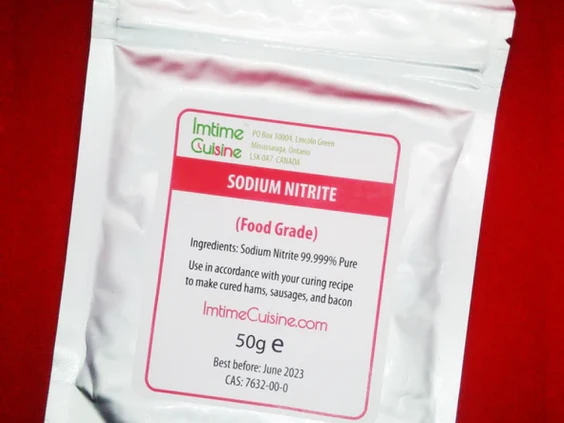Sodium Nitrite, a chemical compound with the molecular formula NaNO₂, is a salt of nitrous acid. It is a crystalline powder or granular substance with various applications across industries.
Historical Context
Sodium Nitrite has a rich historical background, with its discovery dating back to the early 19th century. Initially used in the dye industry, it found its way into food preservation, particularly meat curing, during the 20th century.
Production and Sourcing
The primary method of producing Sodium Nitrite involves the reaction of sodium carbonate (soda ash) with nitric acid. It is available as a white to slightly yellowish crystalline powder and is sourced from chemical manufacturers.
Applications
Sodium Nitrite serves several essential applications:
- Food Preservation: It is commonly used as a food additive to preserve processed meats, such as bacon, sausage, and ham. Sodium Nitrite inhibits the growth of bacteria, particularly Clostridium botulinum, preventing foodborne illness.
- Chemical Industry: Sodium Nitrite finds applications in various chemical processes, including the production of dyes, pharmaceuticals, and other chemicals.
- Medicine: In medicine, Sodium Nitrite can be used as an antidote for cyanide poisoning. It converts hemoglobin into methemoglobin, which has a higher affinity for cyanide ions, effectively detoxifying the body.
Regulatory Framework
The use of Sodium Nitrite in food preservation is regulated by health authorities in different countries. Strict limits and guidelines are in place to ensure its safe usage and to prevent excessive intake.
Consumer Concerns
Consumer concerns often revolve around the potential health risks associated with the consumption of processed meats containing Sodium Nitrite. Some studies have suggested a link between the consumption of such meats and certain health issues.
Health and Safety
Sodium Nitrite’s safety is a critical consideration. When used within prescribed limits, it helps prevent botulism and ensures the safety of processed meats. However, excessive consumption may have health implications.
Applicable Products
Products that may contain Sodium Nitrite include:
- Processed Meats: Bacon, sausages, hot dogs, and deli meats.
- Chemical Products: Dyes, pharmaceuticals, and corrosion inhibitors.
- Medications: Antidotes for cyanide poisoning.
Alternatives
Alternative methods of food preservation, such as natural curing processes using ingredients like celery juice or cherry powder, aim to achieve similar results without the use of Sodium Nitrite.
Scientific Research
Scientific research often focuses on assessing the potential health risks and benefits of Sodium Nitrite consumption, as well as exploring alternative food preservation methods.
Chemical Properties
Sodium Nitrite’s chemical properties include its solubility in water and its ability to form nitrous acid when dissolved. Its chemical structure consists of sodium (Na), nitrogen (N), and oxygen (O) atoms.
Case Studies
Case studies related to Sodium Nitrite primarily examine its use in food preservation and its effects on food safety and shelf life.
Future Trends
Future trends in the food industry may involve the development of new and innovative food preservation techniques that reduce the reliance on Sodium Nitrite while maintaining food safety standards.
Opinions
Opinions on Sodium Nitrite in food vary. Some emphasize its essential role in preventing foodborne illness, while others raise concerns about potential health risks associated with its consumption.
Warnings
Warnings regarding Sodium Nitrite consumption often pertain to its use in processed meats. Consumers are advised to consume such products in moderation and as part of a balanced diet.
Synonyms
Synonyms for Sodium Nitrite include “E250” (its European food additive number) and “sodium salt of nitrous acid.”
Conclusion
Sodium Nitrite plays a vital role in food preservation and safety, particularly in preventing botulism in processed meats. While it is subject to regulatory controls and guidelines, ongoing research and evolving food industry trends aim to address consumer concerns and explore alternative preservation methods to ensure food safety and quality.







